RBSE Solutions for Class 5 Environmental Studies Chapter 25 Our Earth and Space is part of RBSE Solutions for Class 5 Environmental Studies. Here we have given Rajasthan Board RBSE Class 5 Environmental Studies Chapter 25 Our Earth and Space.
| Board | RBSE |
| Textbook | SIERT, Rajasthan |
| Class | Class 5 |
| Subject | Environmental Studies |
| Chapter | Chapter 25 |
| Chapter Name | Our Earth and Space |
| Number of Questions | 56 |
| Category | RBSE Solutions |
Rajasthan Board RBSE Class 5 Environmental Studies Chapter 25 Our Earth and Space
Text Book Questions
Points for discussion (Page No. 143)
Question 1.
What all have you seen in the sky?
Answer:
We have seen polar star, stars, moon and sun in the sky.
Question 2.
Why cannot we see directly towards the sun?
Answer:
Due to the sun’s bright light we cannot see directly towards the sun.
Explore and write the answers of the following (Page No. 145)
Question 1.
Observe the Saptarishi constellation in the sky at night and draw its picture.
Answer:
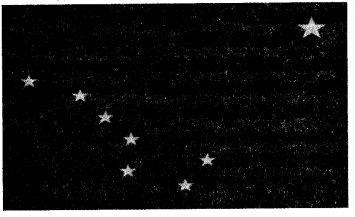
Question 2.
What else do you see in the sky? Draw their pictures also.
Answer:
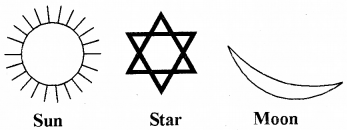
Explore and know (Page No. 145)
Question 1.
What is the difference between an aeroplane and a spacecraft?
Answer:
An aeroplane can move anywhere in the earth, but a spacecraft can move only in the space. A spacecraft moves 50 times faster than an aeroplane.
Question 2.
If you go to the space, what preparations you would take?
Answer:
The preparation for a space travel includes the following:
- The practice of eating a different kind of food.
- To work in specific conditions
- To live in the absence of gravitational force.
- To live in high pressure and weightlessness.
Question 3.
Which Indians have travelled to the space? Gather information about them from your school’s library.
Answer:
Rakesh Sharma was the first Indian astronaut who went to the space. The women astronaut from India who travelled to the space are Kalpana Chawla and Sunita Williams
(Note: Students to collect information on these astronauts from the school’s library and write in their notebook).
Question 4.
How would our earth look like when seen from the moon?
Answer:
When seen from the moon, our earth would look like a ball.
Points for discussion (Page No. 146)
Question 1.
Look at the figure and tell what the astronauts are wearing?
Answer:
Astronauts wear a special space-proof suit connected to specific machines in the spacecraft.
Question 2.
Can we go to the space?
Answer:
Yes, we can go to the space.
Question 3.
How can we go to the space?
Answer:
We can go to the space by a spacecraft.
Think and write the answers of the following (Page No. 146)
Question 1.
Imagine that you are going on space travel. Describe your experiences of space travel in detail in your notebook.
Answer:
Note : Students to write on their own.
Explore and collect (Page No. 146)
Question 1.
Gather information about the astronauts and paste their pictures in your notebook.
Answer:
Note : Students to do on their own.
Observe and tell the answers of the I following (Page No. 147)
Question 1.
Write the name of the planet nearest to the sun.
Answer:
Mercury is the nearest planet to the sun.
Question 2.
Which is the biggest planet of the solar system?
Answer:
Jupiter is the biggest planet in the solar system.
Question 3.
Write the names of the 8 planets from the sun in sequence.
Answer:
The 8 planets of the sun – Mercury. Venus, Earth, Mars, Jupiter, Saturn, Uranus, Neptune.
Question 4.
Do the moon, the satellite of the earth, revolves around it?
Answer:
Yes, moon, the satellite of the earth, revolves around it.
Question 5.
Observe the changes in the shape of the moon in the given picture.Write the dates (tithi) on which these views of the moon ,are visible.
Answer:
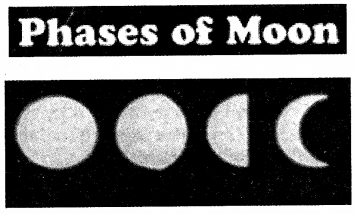
Note: Changes in the shape of the moon.
Picture 1 : Ditiya
Picture 2 : Panchmi
Picture 3 : Teras
Picture 4 : Poomima
Explore and write the answers of the following (Page No. 147)
Question 1.
On the dates (tithi) corresponding to the images of the moon shown above, which are the festivals, functions, fairs etc. that we celebrate?
Answer:
Bhai Douj on ditiya, Basantpanchmi on panchmi. Shivratri on teras, holi and rakhi etc. on poornima.
Question 2.
Is any fair organised during these days?
Answer:
In Basantpanchmi and shivratri, fairs are organised.
Question 3.
What do the members of your family do during these days?
Answer:
The family members keep fast these days and worship gods and goddesses. They also distribute food and cloth to the poor people on these days.
Learnt, understood and now tell (Page No. 148)
Question 1.
Who is the head of the solar system?
Answer:
The head of the solar system is sun.
Question 2.
Make a list of Indian astronauts.
Answer:
Rakesh Sharma, Kalpana Chawla, Sunita Williams.
Question 3.
Why are the stars not visible during day time?
Answer:
Due to the sun’s bright light we cannot see the stars during the day time.
Question 4.
Which planet has a ring around it?
Answer:
Saturn.
Other Important Questions
Objective Type Questions :
Question 1.
Kalpana Chawla is remembered with honour because : (Model Paper)
(a) She was the first Indian woman to fly an aeroplane.
(b) She was the first Indian woman to travel into space.
(c) She had discovered a star.
(d) She was the first Indian mountaineer.
Answer:
(b) She was the first Indian woman to travel into space.
Question 2.
Rakesh Sharma is remembered with honour because :
(a) He was the first Indian astronaut
(b) He was the first mountaineer
(c) He was the first geo-scientist
(d) He invented the medicine for cancer.
Answer:
(a) He was the first Indian astronaut
Question 3.
Many small are seen twinkling in the night sky.
(a) Stars
(b) Sun
(c) Spacecraft
(d) Moon
Answer:
(a) Stars
Question 4
star helps the travellers to locate the right direction.
(a) Broken
(b) Polar
(c) Moon
(d) Saptarishimandal
Answer:
(b) Polar
Question 5.
The largest planet of the solar system.
(a) Earth
(b) Mars
(c) Saturn
(d) Jupiter
Answer:
(d) Jupiter
Question 6.
A special type of is used to go to the space.
(a) Aeroplane
(b)Ship
(c) Helicopter
(d) Spacecraft
Answer:
(d) Spacecraft
Question 7.
First Indian astronaut who went to space.
(a) Rakesh Sharma
(b) Kalpana Chawla
(c) Sunita Williams
(d) Bachendri Pal
Answer:
(a) Rakesh Sharma
Fill in the blanks :
1. Moon shines through the light of…………. (own / sun)
2. Polar, star indicates …………. direction. (east / north)
3. On the day of …………. the moon is not visible. (amabasya / sun)
4. The moon revolves around the ……………… (sun / earth)
5. There are ………… planets of the sun. (8 / 9)
Answer:
1. sun
2. north
3. amabasya
4. earth
5. 8
Very Short Answer Type Questions :
Question 1.
From where do the stars get the light?
Answer:
The stars have their own light.
Question 2.
From whose light does the moon shine?
Answer:
The moon shines through the light of the sun.
Question 3.
Who is the first Indian astronaut to go to the space?
Answer:
Rakesh Sharma.
Question 4.
Why is the moon called the satellite of the earth?
Answer:
Since the moon revolves around the earth, it is called the satellite of the earth.
Question 5.
Write the names of 2 women who travelled to the space from India.
Answer:
(a) Kalpana Chawla
(b) Sunita Williams
Question 6.
How many planets are there in our solar system?
Answer:
There are 8 planets in our solar system.
Question 7.
A collection of seven great stages or saptarishi constellation is called.
Answer:
Saptarishimandal.
Question 8.
In saptarishimandal, which star always lies in the northern direction?
Answer:
The polar star.
Question 9.
Which direction is indicated by the polar star?
Answer:
Northern direction.
Question 10.
Which star helps the travellers to locate the right direction during the night?
Answer:
Polar star.
Question 11.
In which day is the moon completely visible?
Answer:
On the day of full moon (poornima).
Question 12.
On which day, the moon is not visible?
Answer:
On the day of dark moon (amabasya) the moon is not visible.
Short Answer Type Questions :
Question 1.
What is saptarishimandal?
Answer:
The extremely bright star is the polar star, which always lies in the northern direction and the sequence of the seven stars is known as the collection of seven great sages or the saptarishi constellation (saptarishimandal).
Question 2.
Where is the polar star situated? What is its importance?
Answer:
At the upper portion of the Saptarishi- mandal, the extremely bright star is the polar star, which always lies in the northern direction.
During night time, the pole star helps the travellers to locate the right direction. In saptarishimandal, the four stars make a square pattern and the other three looks like a tail.
Question 3.
Where do moon and stars go during the day?
Answer:
The moon and the stars do not go anywhere during day time. We cannot see them because of the bright sunlight. When it becomes dark; they become visible,
Question 4.
What is the breaking star?
Answer:
The breaking star is the meteorite mass that burns when it comes into the earth’s atmosphere.
Question 5.
Why does the moon look big and the stars look small?
Answer:
The stars are very far from us. So they appear very small. On the other hand, the moon is nearer to us and so it appears bigger.
Essay type questions
Question 1.
Does the shape of the moon always look the same?
Answer:
The moon is the satellite of the earth that revolves around it. It does not have its own light. It shines by means of the light of the sun. The moon does not always look of the same shape. The size of the moon increases from first lunar day (ekum) to the day of the full moon (poornima) and then decreases after this. On the day of the dark moon (amabasva), the moon is not visible. This increasing-decreasing sequence of the moon is called the arts of the moon.
Question 2.
What is a spacecraft?
Answer:
A special type of spacecraft is used to go to the space. A spacecraft flies 50 times faster than an aeroplane. It requires a lot of fuel to fly faster
Question 3.
Describe the main points about the sky.
Answer:
(i) Many small stars are seen twinkling in the sky at night.
(li) The moon even looks round, shining and beautiful in the sky at night.
(iii) During the day time the moon and the stars are not visible in the sky
(iv) During the day time only bright sunlight is seen in the sky.
(v) We cannot see stars and moon during the day time because of bright sunlight.
(vi) The stars have their own light but the moon does not have its own light. It shines through the light of the sun.
(vii) A collection of seven great sages or Saptarishi Constellation (Saptarshimandal).
(viii) Extremely bright star is the polar star which always lies in the north direction During night time, the pole star helps the travellers to locate the right direction.
Question 4.
Make a diagram of solar system and explain it.
Answer:
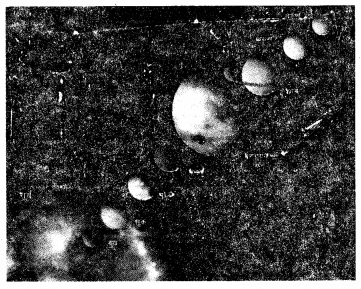
(i) The sun is the head of the solar system.
(ii) There are 8 planets of the solar system and all the planets revolve around the sun
(iii) The name of the 8 planets are Mercury, Venus. Earth. Mars, Jupiter, Saturn, Uranus and Neptune.
(iv) The nearest planet to the Sun is Mercury and Neptune is the farthest planet from the Sun.
(v) Smallest planet is Mercury and Jupiter is the largest planet in the solar system.
(vi) We live on the earth and only on the earth because the favourable condition for life is available on it.
Question 5.
Draw the 3 pictures of the changes in the phases of the moon from Amabasvato Poornimaand then explain them. (Model Paper)
Answer:
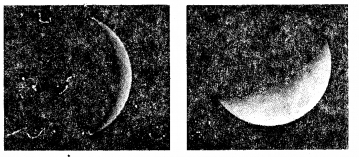
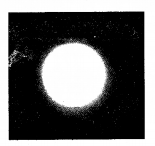
The size of the moon keeps increasing and decreasing. The size of the moon increases from 1 st Lunar day (Ekum) to the day of the full moon (Poornima) and then decreases after this. On the day of dark moon (Amabasva), the moon is not visible.
The shapes of the moon in the above picture are Ditiya, Panchami and Poomima
Question 6.
There are eight planets in the solar system Mercury, Venus, Earth, Mars, Jupiter, Saturn, Uranus and Neptune.
Answer the following questions. (Board Paper)
(a) What is the name of the planet which is nearest to the Sun.
Answer: Mercury is the nearest planet to the Sun.
(b) Which is the largest planet in the solar system?
Answer: Jupiter is the largest planet in the solar system.
(c) On which planet, do you live?
Answer: We live on the planet Earth.
We hope the RBSE Solutions for Class 5 Environmental Studies Chapter 25 Our Earth and Space will help you. If you have any query regarding Rajasthan Board RBSE Class 5 Environmental Studies Chapter 25 Our Earth and Space, drop a comment below and we will get back to you at the earliest.